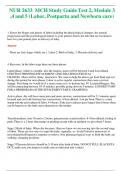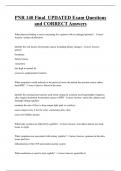NUR 2633 MCH Study Guide Test 2, Module 3
,4 and 5 (Labor, Postpartu and Newborn care)
1. Know the Stages and phases of labor including the physiological changes, the normal
progression and the psychological impact to your patient. Know the labs that are essential to
have for your patient prior to delivery of baby.
Answer
- There are four stages which are 1. Labor 2. Birth of baby, 3. Placenta delivery and
4. Recovery. In the labor stage there are three phases.
Latent phase, which is variable, also the longest, mom will be between 0 and 4cm dilated
CERVIX IS THINNING(EFFACEMENT) AND DILATING(CERVICAL
CHANGE). Mom will be chatty, interactive. We want to help the uterus get food fluid and rest
during this period for next phases. Labor is active regular contractions that cause cervical
change. First thing we would do if a mom comes in is to hydrate her, IV Lactated Ringers. She
will be contracting between 10-15 minutes, possibly going down to 5 minutes. LONGEST PART
FOR A PRIMIGRADA IS THE EFFACEMENT PART( CRAMPING)
Active phase, she will have more pain and more anxious, contractions will be 2-3 minutes apart,
focused and can't talk between her contractions, 4-8cm dilated, 1cm per hour.There is a time
stamp with the active phase of labor, 4-6 hours. If the active phases goes longer than 6 hours there
can be hypoxia to the baby and exhaustion to the mother.
Transition phase, lasts 30 min to 2 hours, pain pressure scared restless. 8-10cm dilated, feeling to
push, There is a 2 hour timestamp on pushing except with an epidural we give them 3 hours.
Stage 2 Birth of baby; When she becomes 10cm we know we are moving into the second stage
of labor. There are two ways to expel the baby vaginally, ac- tively(Valsalva maneuver) or
nonvoluntarily(Ferguson's response or reflex). Non pharmacological ways to birth the baby are
walking, changing positions
Stage 3 Placenta delivery should be 5-30 min after birth of baby, DO NOT PULL PLACENTA
OUT, make sure you inspect to make sure no infection and is intact
,Stage 4 Recovery stage is 2 hours post delivery, assess lochia, fundus should be firm and at or
near umbilicus
*web x*
*postpartum assessment initially on the pt while were still there in recovery*
1. vital signs 15mins for the first hour
2. check bleeding or lochia
3. check fundus (@ umbilicus)
4. ambulate to the rr if the anestia wore off if she has had an epidural
5. get her up and let her void independently. if she cannot void put a foley in
6. *she is preeclampsia in labor and now she has just delivered. we have to maintain mag and put
the foley back in* now shes going to get 2 sterile procedure instead of just 1. procedure is
sensitive, hopefully she still has anesthesia.
7. BEST PAIN RELIEF FOR A POST PARTUM PT WOULD BE NSAIDS- MOTRIN
(BEST)
2. Mastitis treatment
Answer
Provide the client with education regarding breast hygiene to prevent and manage mastitis.
Ï Instruct the client to thoroughly wash hands prior to breastfeeding.
Ï Instruct the client to maintain cleanliness of breasts with frequent changes of breast pads.
Ï Encourage the client to allow nipples to air dry. Ï Teach the client proper infant
positioning and latching on techniques, including both the
nipple
and the areola. The client should release the infant's grasp on the nipple prior to removing the
infant from the breast.
Ï Instruct the client about completely emptying her breasts with each feeding to prevent milk
stasis, which provides a medium for bacterial growth.
Ï Encourage the client to use ice packs or warm packs on affected breasts for discomfort.
,Ï Instruct the client to continue breastfeeding frequently (at least every 2 to 4 hr), especially on
the affected side. Ï Instruct the client to manually express breast milk or
use a breast pump if breastfeeding is too painful.
Ï Instruct the client to begin breastfeeding from the unaffected breast first to initiate the letdown
reflex in the affected breast that is distended or tender.
Ï Encourage rest, analgesics, and fluid intake of at least 3,000 mL per day.
Ï Encourage the client to wear a well fitting bra for support.
Ï Tell the client to report redness and fever.
Ï Administer antibiotics, and teach the client the importance of completing the entire course of
antibiotics as prescribed.
3. coarctation of the aorta.
Answer
There is a narrowing next to the ductus arteriosus that results in an increased pressure proximal
to the defect, with a decreased pressure distal to the obstruction. Therefore, an increased blood
pressure in the arms with a decreased blood pressure in the legs would be a clinical
manifestation of a coarctation of the aorta.
4. caput succedaneum
Answer
Crosses the suture lines- fluid felt on 1 side- general swelling
Caput succedaneum is edema of the presenting part of the newborn's head due to pressure
during labor. The edema extends across the suture lines of the skull.
A cephalhematoma is a swelling, indicating bleeding under the subcutaneous tis- sues of the
newborn's scalp. The collection of blood is beneath the periosteum of the cranial bone and
therefore does not cross the suture line.
Pilonidal dimple can be observed when assessing the vertebral column and can be associated
with spina bifida.
Molding is a temporary misshaping of the fetal head due to overlapping cranial bones at the suture
, lines to accommodate the passage of the fetal head through the birth canal.
5. Know the reasons and the findings of each vaginal exam.
Answer
Five things we can look for in a vaginal exam are effacement, dilation, station, presenta-
tion(hands,feet,butt,shoulder, arm, face) and rupture membranes or intact. A patient is 380 and -2
that means she is 3 cm dilated, 80% effaced and -2 means baby's
head is 2 cm above the ischial spine, in latent phase. Remember +4 on the floor. If she is 890 and
0, then she is 8cm 90% effaced and at the ischial spine, in active phase.
*web x*
*3 PIECES OF INFO WE MUST GET*
1. STATION
Answer
stage of presenting part at the ischial spine
2. dilation
Answer
cervix opening from nothing to 10cm in diameter
3. effacement
Answer
thinning- we go from being 0% effaced to 100% effaced. 100 meaning it is completely thinned
out. effacement is done first





